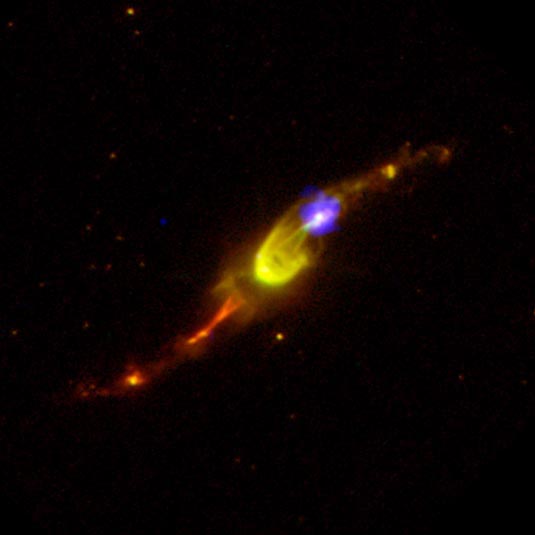
Fast Winds from a Dying Star
White Dwarfs & Planetary Nebulas
RA 17h 45m 14.20s Dec -17º 56' 47.00"
Sagittarius
Image is 18 arcsec
July 15, 2002
14 hours
X-ray: Blue; Optical/IR: Red & Green
ACIS
About 18,000 light years
X-ray: NASA/CXC/RIT/J.Kastner et al.;
Optical: NASA/STScI/Univ. MD/J.P.Harrington
May 10, 2006
ESA, Hubble image: N0308
ABOUT THIS IMAGE:
This image of Henize 3-1475 is part of a composite panel released by the Chandra X-ray Telescope in May 2006. For specific information about Hen 3-1475 see the ESA release.
This panel of composite images shows part of the unfolding drama of the last stages of the evolution of sun-like stars. Dynamic elongated clouds envelop bubbles of multimillion degree gas produced by high-velocity winds from dying stars. In these images, Chandra's X-ray data are shown in blue, while green and red are optical and infrared data from Hubble.
Planetary nebulas - so called because some of them resemble a planet when viewed through a small telescope - are produced in the late stages of a sun-like star's life. After several billion years of stable existence (the sun is 4.5 billion years old and will not enter this phase for about 5 billion more years) a normal star will expand enormously to become a bloated red giant. Over a period of a few hundred thousand years, much of the star's mass is expelled at a relatively slow speed of about 50,000 miles per hour.
This mass loss creates a more or less spherical cloud around the star and eventually uncovers the star's blazing hot core. Intense ultraviolet radiation from the core heats the circumstellar gas to ten thousand degrees, and the velocity of the gas flowing away from the star jumps to about a million miles per hour.
This high speed wind appears to be concentrated into opposing supersonic funnels, and produces the elongated shapes in the early development of planetary nebulas (BD+30-3639 appears spherical, but other observations indicate that it is viewed along the pole.) Shock waves generated by the collision of the high-speed gas with the surrounding cloud create the hot bubbles observed by Chandra. The origin of the funnel-shaped winds is not understood. It may be related to strong, twisted magnetic fields near the hot stellar core.
'Jets' are long outflows
of fast-moving gas found near many objects in the Universe, such as around
young stars, or coming from black holes, neutron stars, and planetary
nebulae, for example. The NASA/ESA Hubble Space Telescope has imaged the
young planetary nebula Henize 3-1475 and its bizarre jet. Astronomers
have nicknamed it the 'Garden-sprinkler' Nebula.
The origin of jets in the Universe is unclear, but they appear to originate
in small regions of space where even Hubble's sharp vision cannot penetrate.
To produce a jet, you require some sort of nozzle mechanism. So far, these
theoretical 'nozzles' remain hidden by dust that obscures our view of
the centres of planetary nebulae. Despite decades of intense effort, there
is no single example of a jet whose origin is clearly understood. The
curious S-shape and extreme high speed of its gaseous outflow gives Henize
3-1475 a special place in the study of planetary nebulae.